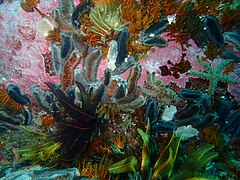The dive site Dome Rock reef is an offshore rocky reef in the Simon's Bay area of False Bay, near Cape Town in the Western Cape province of South Africa.
Understand
edit

Position
edit1 Dome Rock reef: S34°11.119' E18°27.776' — (16m pinnacle)
This site is in a Marine Protected Area (2004). A permit is required. The site is almost entirely within the Boulders Restricted Zone of the Cape Peninsula Marine Protected Area
Name
editThe site was named "Dome Rock" by the first diver known to have dived there, who reported a large domed pinnacle.
Depth
editMaximum depth is about 25 m on the surrounding sand, and the top of the pinnacle is about 16 m. (Average depth for a dive is likely to be about 22 m.)
Visibility
editVisibility is likely to be similar to the nearby reefs, but may be a bit better than the shallower areas if there is a significant swell.
Topography
editThe site comprises two adjacent areas of reef. To the south there is a large outcrop of granite, rising from the sand bottom at about 24 m to a small pinnacle at about 16 m. This area of reef is about 60 m from east to west and about 40 m from north to south, with the pinnacle about central on the south edge. The northern section is similar in size, but relatively flat and quite close to the southern section across a sandy gap with scattered boulders. There are other outlying areas of low reef to the south and west that have not yet been surveyed, and no information is available about them.
Geology: Pre-cambrian granite of the Peninsula pluton, surrounded by fine quartz sand.
Conditions
editThe site is exposed to south easterly winds and waves, so should be dived in westerly winds. The site is reasonably protected from swells from the south west.
The site is usually at it's best in autumn, winter or spring, but there are also occasional opportunities in summer.
Get in
editThis reef is only accessible by boat. The site is about 3.2 km from Simon's Town jetty, or 4.6 km from Miller's Point slipway.
See
editMarine life
editThe reef is typical for this region and depth range. There is the usual heavy encrustation of echinoderms, including feather stars, brittle stars and sea cucumbers, and a moderate number of sea fans, soft corals and anemones. There will probably be small shoals of hottentot seabream and a few other reef fish, like klipfish, fingerfins and Roman.
- Striped anemone
- Strawberry anemones
- Close-up of the sinuous sea fan Eunicella tricoronata
- Scrolled false coral
- Cup corals Balanophyllia bonaespei
- Malacacanthus capensis - Sunburst soft corals
Photography
editMacro photography is likely to produce good results on most dives.
Suggested Routes
editNo particular routes recommended, the main section of the reef is small enough to explore on a single dive, and there is only one significant pinnacle.
Stay safe
editNearby
edit- 1 Castor Rock - Central Pinnacle
- 2 Friskies Pinnacle
- 3 Roman Rock
- 4 Tivoli Pinnacles
- 5 Rambler Rock Southern pinnacles
- 6 Noah’s Ark - Eastern wreck
- 7 Ammo Reef
- 8 Anchor Reef
Back to the Alphabetical list of sites, or list of dive sites in the Roman Rock area
Other regional dive sites:
- Dive sites of Table Bay and approaches,
- Dive sites of the Cape Peninsula west coast
- Dive sites of False Bay offshore and approaches
- Dive sites of False Bay east coast
- Fresh water dive sites of the Cape Town Metropolitan Area







